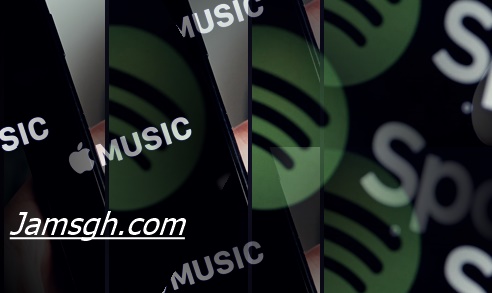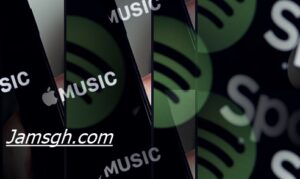Spotify vs. Apple Music: Which Pays More for Ghanaian Artists?


The rise of music streaming platforms has dramatically transformed the music industry, providing artists with unprecedented access to global audiences. For Ghanaian musicians, platforms like Spotify and Apple Music have become vital revenue streams in their careers. However, when it comes to generating income, a common question arises: which of these two platforms pays more for Ghanaian artists?
While both Spotify and Apple Music have global reach, their payment structures, audience demographics, and royalty rates differ. To answer the question of which platform offers the better payout, we need to look at how each streaming service works, the factors influencing artist earnings, and how these platforms specifically impact Ghanaian artists.
Understanding the Payment Structures of Spotify and Apple Music
Before diving into comparisons, it’s crucial to understand how Spotify and Apple Music pay artists. Both platforms use streaming-based revenue models, but there are distinct differences in how they allocate payments.
Spotify’s Payment System
Spotify operates under a pro-rata payment model, meaning that artists are paid based on a share of Spotify’s monthly revenue relative to the total amount of streams on the platform. The total revenue generated by Spotify is divided among all the artists based on their percentage of total streams.
Here’s a breakdown of how Spotify payments generally work:
Revenue Split: Spotify pays artists a share of their ad and subscription revenue. However, only about 70% of Spotify’s total revenue goes to rights holders (including record labels, producers, and the artists themselves).
Payment Per Stream: The average payout per stream is often cited as $0.003 to $0.004, though it can vary based on factors such as location, subscription type, and artist popularity.
Spotify’s Role in Artist Earnings: The major distinction with Spotify’s model is that it takes a significant portion of revenue for licensing rights and other costs. As a result, artists typically earn much less per stream compared to other platforms, especially when they are signed to record labels that take a percentage.
Apple Music’s Payment System
Apple Music, on the other hand, uses a user-centric payment model. This means that the royalties paid to artists are directly tied to the subscription fees from individual users, rather than the total streams across the platform. When a listener subscribes to Apple Music, their monthly payment contributes directly to the royalties distributed to the artists they listen to.
Here’s how Apple Music’s payments break down:
Revenue Split: Apple Music pays a higher percentage of revenue to rights holders than Spotify, around 71.5% of its total revenue. Apple also doesn’t rely as heavily on ads for monetization.
Payment Per Stream: Apple Music’s per-stream payout is generally $0.006 to $0.0084, which is significantly higher than Spotify’s rate.
Artist Earnings: Apple Music’s model is more favorable to artists in terms of per-stream payouts. However, this can be offset by the platform’s smaller user base compared to Spotify.
Factors Affecting Artist Earnings on Both Platforms
1. Audience Size and Reach
Spotify is undeniably the bigger player in terms of audience. With over 500 million active users globally (including free and premium users), the platform offers a vast potential reach. However, this also means that the competition for attention is fierce. For Ghanaian artists who want to break into international markets, Spotify provides more opportunities to gain streams.
On the other hand, Apple Music has a smaller user base but tends to cater to a more niche, high-income audience. While its reach is not as expansive as Spotify’s, it is considered more lucrative per listener. For Ghanaian artists focusing on high-end markets (such as the U.S., Europe, and urban centers), Apple Music may provide a more targeted audience.
2. Global vs. Regional Reach
Spotify’s global reach is an advantage, especially in markets like the United States, Europe, and parts of Asia. However, Apple Music has gained ground in specific regions, particularly in the U.S. and parts of Europe. For Ghanaian artists, this distinction matters depending on where their fan base is located. Artists who have significant followings in the African diaspora, or in countries where Apple Music has a strong presence, may find better earnings on Apple Music.
3. Music Catalog and Licensing
Another factor influencing artist payments is the licensing agreements between Spotify and Apple Music with record labels. While both platforms offer a wide catalog of music, record label deals can affect how much artists earn. If a Ghanaian artist is signed to a label, the payout percentage often gets divided between the artist, the label, and other stakeholders. Independent artists might earn more directly, but they still have to factor in distribution fees and marketing expenses.
4. Type of Subscription: Free vs. Paid
Spotify has both free (ad-supported) and premium (subscription-based) users. The majority of Spotify’s revenue comes from premium subscriptions, but free-tier listeners also contribute to the overall pool of revenue, though they generate significantly less per stream. Conversely, Apple Music is a paid-only subscription service, which generally means its listeners are more committed and willing to pay for music, resulting in higher payouts per listener.
Comparing Artist Earnings: Spotify vs. Apple Music for Ghanaian Artists
Now that we understand how the platforms operate, let’s focus on which one offers better payouts for Ghanaian artists specifically.
Spotify: The Pros and Cons
Pro: Global Audience – Spotify’s massive user base means that Ghanaian artists have a broader potential audience, especially for music genres that resonate internationally, like Afrobeats, Highlife, and Hiplife.
Pro: Access to Playlists – Spotify is known for its algorithm-driven playlisting, which can significantly boost streams for artists who land spots on popular playlists. For emerging Ghanaian artists, getting on the right playlist can lead to exponential growth.
Con: Lower Payouts Per Stream – While Spotify offers better reach, the payouts per stream are relatively low. A Ghanaian artist with moderate streams might earn less on Spotify compared to Apple Music, especially if they don’t have a massive following.
Con: Heavy Competition – The sheer volume of content on Spotify makes it difficult for new artists to stand out unless they have a highly engaging fanbase or a viral track.
Apple Music: The Pros and Cons
Pro: Higher Payouts Per Stream – Apple Music offers higher payouts per stream, which means Ghanaian artists could earn more for each play, especially from dedicated listeners.
Pro: Stronger Focus on Music Quality – Apple Music tends to cater to listeners who are more invested in music, and its platform is more oriented towards long-form listening and artist discovery.
Con: Smaller User Base – Although Apple Music’s revenue per user is higher, its smaller audience means fewer streams overall. Ghanaian artists may struggle to generate the same volume of streams on Apple Music as they would on Spotify.
Con: Less Algorithmic Promotion – While Apple Music does have curated playlists and editorial features, its algorithm is not as aggressive as Spotify’s when it comes to playlist recommendations, making organic growth on the platform more difficult.
Which Platform Pays Better for Ghanaian Artists?
Based on the per-stream rates and payment structures, Apple Music pays more per stream than Spotify. However, Spotify offers a far larger audience and more opportunities for playlisting, which can lead to greater overall earnings if a Ghanaian artist gains traction. Therefore, the answer to which platform pays better depends on the artist’s strategy:
For artists who prioritize volume and global reach, Spotify may be the better choice despite its lower per-stream rate.
For artists who have a more dedicated fanbase or cater to higher-income listeners, Apple Music could provide higher payouts for each stream.
Ultimately, a balanced strategy of utilizing both platforms, optimizing for each’s strengths, and engaging with audiences on social media can help Ghanaian artists maximize their revenue. Both Spotify and Apple Music offer distinct advantages, and the best choice depends on an artist’s specific goals, market, and audience engagement strategy.
While both Spotify and Apple Music have their merits, it’s clear that Apple Music offers higher payouts per stream, making it a potentially more profitable option for Ghanaian artists, especially those with a dedicated following. However, Spotify’s global reach, extensive playlisting opportunities, and larger user base provide significant growth opportunities. To truly succeed, many Ghanaian artists may find that leveraging both platforms is the most effective way to optimize their income and build a broad, sustainable fanbase.
Source: Jamsgh.com





